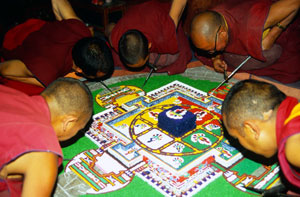|
|
|
Ladakh Mandalas |
|
|
|
Mandalas in Ladakh, also known as the
architecture of enlightenment, is an ancient Hindu and
Buddhist graphic symbol of the universe. It is a cosmic
diagram that functions as a powerful aid in meditation and
concentration. In Sanskrit, it means circle, polygon,
community, connection. The Mandala is a symbol which acts as a
support for the meditating person. The mandala is often
illustrated as a palace with four gates, facing the four
corners of the Earth. |
|
|
|
|
|
The word "mandala"
comes from the Sanskrit verbal root "mand" (meaning to
mark off, decorate, set off) and "la" (meaning circle,
essence, sacred center). The mandala's symbolic power
can be traced back to the Indian temple architecture,
which created sacred spaces linking the worshiper to the
larger cosmos. In these temples, time and space were
represented in a vocabulary of circles and squares.
Similarly, a mandala helps believers visualize the
universe and their place in it, often in relation to a
specific deity found in the center of the image.
Mandalas are used in the rituals of tantric initiation.
They are constructed at the beginning of the initiation,
out of grains of colored sand carefully placed on a
specially prepared platform. Thus mandalas, like
|
 |
|
|
Vedic altars, are temporary
structures built of impermanent materials. While, the
mud-bricks of altars are simply abandoned after the ritual
sacrifice, mandalas are deliberately destroyed, their sand
swept up upon completion of the initiation and poured into a
nearby stream or river. |
|
|
|
All monks at Tibetan
Buddhist monasteries in Ladakh are required to learn how to
construct mandalas as part of their training. The
learning process is two-fold, including the memorization
of texts that specify the names, lengths, and positions
of the primary lines that define the basic structure of
mandalas, as well as the manual techniques of drawing
and pouring sand. These texts, however, do not describe
every line, nor every detail of each mandala |
 |
|
|
but rather serve as mnemonic
guides to the complete forms of mandalas that must be learned
from the repeated practice of construction under the guidance
of experienced monks. It is believed that in his enlightened
form, the Buddha is no longer in this world. As one of his
epithets indicate, the Buddha is tathagata, or "thus-gone,"
and in the absence of his physical body, the mandala
represents his "body of enlightenment." Thus this stunning
ancient art form occupies a significant religious role in
Buddhism. |
|